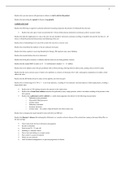Summary
Summary Evergreen Valley College - NUR 101|NCLEX passing it,Complete solution guide_2022
- Course
- NUR 101
- Institution
- Evergreen College ( )
Realize that you must answer all questions in relation to what’s safe for the patient Realize that preventing the spread of disease is top priority CADIOVASCULAR Realize the following in regards to a plasma cholesterol screening (measures the amount of cholesterol that one has): x Realize tha...
[Show more]



